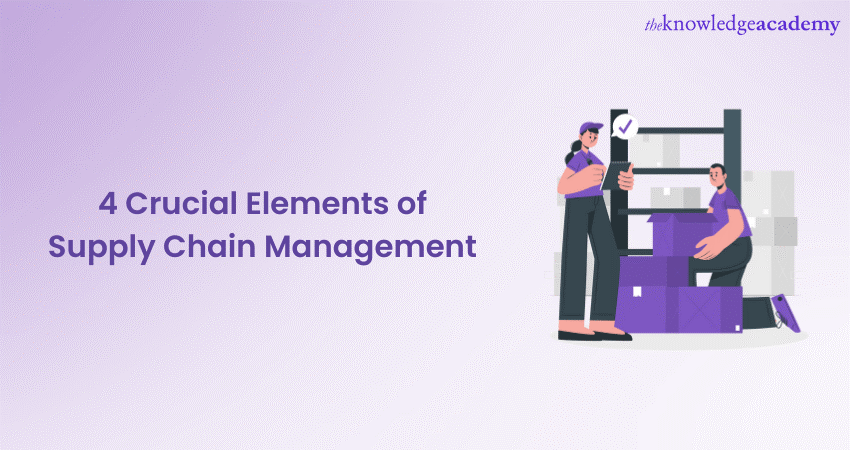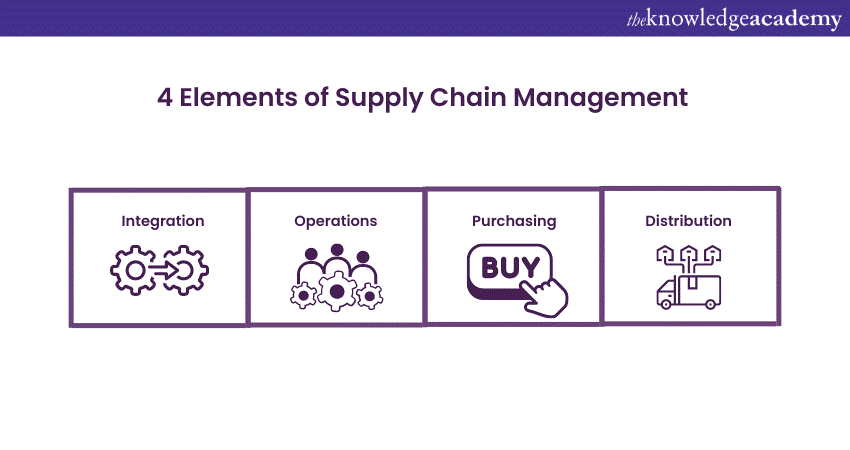We may not have the course you’re looking for. If you enquire or give us a call on +971 8000311193 and speak to our training experts, we may still be able to help with your training requirements.
Training Outcomes Within Your Budget!
We ensure quality, budget-alignment, and timely delivery by our expert instructors.

Supply Chain Management (SCM) oversees the flow of goods and services from the origin to the consumer. It involves designing, organising, and managing suppliers, producers, distributors, retailers, and end-user to achieve optimal efficiency and effectiveness. SCM encompasses everything from production to product development to managing information to guide these activities. Understanding the components of supply chain management is crucial for businesses looking to enhance operational efficiency. There are four key Elements of Supply Chain Management.
According to Statista, the international Supply Chain Management market will be valued at 24 billion GBP by 2026. Read this blog to learn the Elements of Supply Chain Management and how they drive operational efficiency to help companies succeed and sustain in the market.
Table of content
1) What are the Elements of Supply Chain Management?
a) Integration
b) Operations
c) Purchasing
d) Distributions
2) Conclusion
What are the Elements of Supply Chain Management?

SCM is an essential aspect of business operations. It is imperative for companies, regardless of the market of their operations, to maintain their Supply Chains effectively. There are four Elements of Supply Chain Management - Integration, Operations, Purchasing, and Distribution. Let's look at these Elements in detail:
Ready to shine in Supply Chain Management? Try our Supply Chain Management Training Course now!
Integration
Integration is the first element of Supply Chain Management, connecting all four elements. It means aligning the strategies, processes, information, and technology of Supply Chain functions and partners. Integration allows goods and services, data, and communication to flow smoothly and seamlessly throughout the Supply Chain. It also helps to reduce costs, errors, delays, and risks by removing unnecessary and inconsistent activities.
Integration needs a strong commitment and involvement from the company's leadership. It also requires a clear vision, mission and goals, and a thorough analysis of the internal and external environment. Integration also involves creating effective mechanisms for collaboration and coordination with suppliers, customers, and other stakeholders. Moreover, Integration needs adopting suitable tools and systems to enable data collection, storage, analysis and sharing. Some of the benefits of Integration are:
a) Improved customer satisfaction and loyalty by fulfilling their needs and expectations.
b) Enhanced competitive advantage by creating value and differentiation.
c) Increased operational efficiency and productivity by optimising resources and processes.
d) Reduced waste and minimised overstocking and understocking of inventory.
e) Increased innovation and flexibility by responding to changes and opportunities.
Unleash your industry potential with top notch Industry Training, tailored to achieve success.
Operations
The second Element of SCM is Operations, which focuses on effectively executing tasks. It means managing the production, storage, transportation, and delivery of goods and services. Operations involve planning, scheduling, monitoring, controlling, and the Supply Chain's performance, processes and resources. It also ensures quality, safety, compliance, and sustainability standards.
Operations require a deep understanding of the demand and supply patterns and capabilities and constraints of the Supply Chain partners. It also requires a continuous evaluation and improvement of the Supply Chain processes and resources to achieve maximum efficiency and effectiveness. Operations also involve implementing Lean Manufacturing Principles and techniques to eliminate waste and enhance values.
a) Some of the benefits of operations are:
b) Increased customer satisfaction and loyalty by delivering quality products and services on time.
c) Enhanced competitive advantage by reducing costs and increasing profits.
d) Increase operational efficiency and productivity by maximising output and minimising input.
e) Reduced risks and uncertainty by preventing or mitigating disruptions.
f) Increased employee engagement and morale by empowering them to participate in decision-making.
Join our renowned Train the Trainer course and gain the expertise you need to inspire and educate others effectively.
Purchasing
The third Element of Supply Chain Management is Purchasing, which focuses on acquiring goods and services from the supplier. It means managing the sourcing, selection, negotiation, contracting and evaluation of the suppliers. Purchasing involves developing and maintaining long-term supplier relationships based on trust, collaboration, and mutual benefit. It also involves ensuring ethical, social, and environmental responsibility.
Purchasing requires a strategic approach to procuring goods and services that aligns with the organisational goals and objectives. It also requires a comprehensive analysis of the supplier market, quality, cost, availability, and reliability of the goods and services. Purchasing also involves implementing effective Supplier Management Practices and tools to monitor and measure the supplier's performance and satisfaction. Some of the benefits of Purchasing are:
a) Increased customer satisfaction and loyalty by sourcing quality products and services at competitive prices.
b) Leveraging the supplier’s expertise and innovations by using their knowledge and creativity to gain an edge over competitors.
c) Reducing inventory and lead time by cutting down on stock delivery time to improve efficiency and productivity.
d) Diversifying the supplier base, mitigating supply disruptions by working with different suppliers, and preventing supply problems to reduce risk and uncertainty.
e) Promoting ethical and sustainable practices in the Supply Chain by supporting fair and green practices in the Supply Chain to increase social and environmental responsibility.
Distribution
The next element of supply Chain Management is distribution, which deals with delivering goods and services to customers. It covers managing customer service, Warehousing, Transportation, and the Importance of Logistics. Distribution means ensuring that goods and services are delivered to the customers promptly, accurately, and cost-effectively. It also means offering value-added services such as Installation, Maintenance, Repair, and Disposal.
Distribution demands a customer-centric approach to delivering goods and services that meets or surpasses customer expectations. In the realm of logistic management, achieving this goal involves not only understanding and adapting to the changing customer demand and preferences but also establishing a flexible and responsive logistics network. This network plays a crucial role in efficiently managing the movement of goods from point of origin to final destination, ensuring timely deliveries and optimizing the overall supply chain. The integration of logistic management strategies into the distribution process becomes paramount in navigating the complexities of today's dynamic market environment. Distribution also entails using effective and efficient transportation, warehousing systems and technologies to optimise the flow of goods and services. Some of the benefits of distribution are:
a) Improved customer satisfaction and loyalty by delivering goods and services at the right place and time with the correct quantity and quality.
b) Enhanced competitive advantage by creating customer value and differentiation.
c) Improved operational efficiency and productivity by reducing transportation and warehousing costs.
d) Improved customer retention and loyalty by providing excellent customer service.

Conclusion
Supply Chain Management is essential for any organisation that wants to achieve its vision and mission. There are four Elements of Supply Chain Management - Integration, Operations, Purchasing, and Distribution. By mastering these elements, you can optimise your Supply Chain performance, cut down your expenses, boost your revenues, delight your customers, and outshine your competitors.
Ever dreamt of being the brains behind the next groundbreaking product? Join our Product Management Training and transform your dream into reality.
Frequently Asked Questions
Upcoming Business Skills Resources Batches & Dates
Date
 Facilitation Skills Training
Facilitation Skills Training
Fri 17th Jan 2025
Fri 28th Mar 2025
Fri 23rd May 2025
Fri 27th Jun 2025
Fri 8th Aug 2025
Fri 17th Oct 2025







 Top Rated Course
Top Rated Course


 If you wish to make any changes to your course, please
If you wish to make any changes to your course, please


